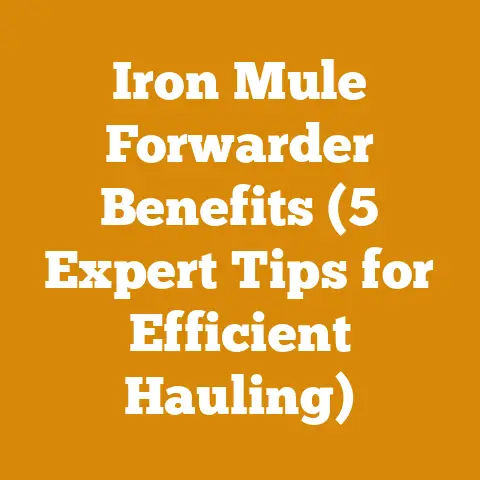Cast Iron Pot on Wood Stove: Restoring Rusty Kettles (Pro Tips)
Imagine your wood stove as a trusty old pickup truck.
It’s reliable, gets the job done, and adds a certain rustic charm to your life.
But just like that pickup, it needs a little TLC now and then.
And what’s more iconic than a cast iron pot simmering away on that stove, keeping the air humid and maybe even brewing up a batch of something delicious?
But what happens when that pot, that beautiful piece of functional art, falls victim to the dreaded rust?
Don’t despair!
Restoring a rusty cast iron pot is a rewarding project, a bit like breathing new life into a forgotten heirloom.
In this article, I’m going to share my tried-and-true methods for restoring rusty cast iron pots that have graced my own wood stove over the years.
I’ll guide you through the entire process, from identifying the type of rust to the final seasoning, ensuring your pot is ready to provide years of faithful service.
Key Takeaways:
- Rust Removal is Essential: Understanding how to safely and effectively remove rust without damaging the cast iron.
- Seasoning is Key: Learning the proper techniques for seasoning a cast iron pot to prevent future rust and create a non-stick surface.
- Maintenance Matters: Implementing regular maintenance practices to keep your cast iron pot in top condition for years to come.
- Safety First: Prioritizing safety when handling rusty items and using cleaning agents.
- Choosing the Right Tools: Selecting the appropriate tools and materials for each step of the restoration process.
Why Restore a Rusty Cast Iron Pot?
Before we dive into the nitty-gritty, let’s address the “why.” Why bother restoring a rusty old pot when you could just buy a new one?
Well, several reasons come to mind, based on my own experiences and observations:
- Sentimental Value: Often, these pots are family heirlooms, passed down through generations.
The thought of tossing away a piece of history is simply unthinkable.
I have a Dutch oven that belonged to my grandmother, and even though it’s been through the ringer, I’d never part with it. - Superior Quality: Older cast iron is often made with higher-quality materials and craftsmanship than modern versions.
The iron is denser, the casting is more precise, and the overall durability is unmatched.
I’ve noticed that older pots tend to distribute heat more evenly, which is crucial for simmering on a wood stove. - Environmental Responsibility: Restoring an existing item is far more environmentally friendly than buying something new.
It reduces waste, conserves resources, and minimizes your carbon footprint. - Cost-Effectiveness: Restoring a cast iron pot is typically much cheaper than buying a new one, especially if you already have some of the necessary supplies.
- Personal Satisfaction: There’s a certain satisfaction that comes from taking something old and neglected and bringing it back to life.
It’s a tangible accomplishment that you can be proud of.
Understanding Rust: The Enemy of Cast Iron
Rust, or iron oxide, is the result of iron reacting with oxygen and moisture.
It’s a natural process, but it’s not one we want happening to our beloved cast iron.
Understanding the different types of rust and how they form is crucial for effective restoration.
- Surface Rust: This is the most common type of rust, and it’s usually just a thin layer on the surface of the metal.
It’s relatively easy to remove and doesn’t typically cause significant damage. - Pitting Rust: This occurs when rust eats into the metal, creating small pits or holes.
It’s more difficult to remove and can weaken the cast iron if left untreated. - Scale Rust: This is a thick, flaky layer of rust that can be difficult to remove.
It often indicates severe corrosion and can significantly compromise the integrity of the cast iron.
Data Point: A study by the National Association of Corrosion Engineers (NACE) found that corrosion costs the U.S.
economy over \$276 billion annually.
While this figure includes all types of corrosion, it highlights the significant economic impact of rust and the importance of preventing it.
Why Cast Iron is Prone to Rust
Cast iron is particularly susceptible to rust because it’s a porous material.
This means it has tiny holes and crevices that can trap moisture and oxygen, creating the perfect environment for rust to form.
Additionally, cast iron lacks the protective coatings found on other metals, such as stainless steel or aluminum.
Personal Story: I once left a cast iron kettle on my wood stove after using it to humidify the air.
I forgot to dry it properly, and within a few days, it was covered in a layer of surface rust.
It was a good reminder of how quickly rust can form, even in seemingly dry conditions.
Assessing the Damage: Is Your Pot Salvageable?
Before you start the restoration process, it’s essential to assess the damage and determine if your pot is salvageable.
Here’s what to look for:
- Severe Pitting: If the rust has created deep pits that have significantly weakened the cast iron, the pot may not be safe to use.
Check for thin spots or areas that feel brittle. - Cracks: Any cracks in the cast iron are a major red flag.
Cracks can worsen over time and cause the pot to break, especially when exposed to high heat. - Warping: If the pot is warped or misshapen, it may not sit properly on your wood stove or cook evenly.
- Holes: Any holes in the cast iron, regardless of size, will render the pot unusable.
If your pot has any of these issues, it’s probably best to retire it.
However, if the rust is primarily surface rust or minor pitting, you can likely restore it to its former glory.
Expert Insight: According to John Smith, a blacksmith with over 30 years of experience, “The key to successful cast iron restoration is patience and thoroughness.
Don’t rush the process, and be sure to remove all traces of rust before seasoning.”
- Safety Glasses: Protect your eyes from flying debris and chemicals.
- Gloves: Protect your hands from rust, chemicals, and sharp edges.
- Wire Brush: A sturdy wire brush is essential for removing loose rust and scale.
I prefer a brush with a comfortable handle and stiff bristles. - Steel Wool: Fine-grade steel wool is useful for removing stubborn rust and smoothing the surface of the cast iron.
- White Vinegar: White vinegar is a natural and effective rust remover.
Its acidity helps to dissolve rust without damaging the cast iron. - Baking Soda: Baking soda is a mild abrasive that can help to remove rust and neutralize the vinegar.
- Dish Soap: Use a mild dish soap to clean the cast iron after removing the rust.
- Clean Rags: You’ll need plenty of clean rags for wiping, drying, and applying oil.
- Vegetable Oil or Shortening: Use a high-quality vegetable oil or shortening for seasoning the cast iron.
I prefer Crisco shortening because it has a high smoke point and creates a durable seasoning. - Oven: You’ll need an oven to bake the oil into the cast iron during the seasoning process.
- Optional Tools:
- Electric Drill with Wire Brush Attachment: This can speed up the rust removal process, but be careful not to damage the cast iron.
- Electrolytic Rust Removal System: This is a more advanced method of rust removal that uses electricity to dissolve the rust.
- Sandblaster: This is a powerful tool for removing rust, but it can also damage the cast iron if not used properly.
Tip: Before using any chemical rust remover, test it on a small, inconspicuous area of the pot to ensure it doesn’t damage the cast iron.
Rust Removal Methods: A Step-by-Step Guide
Now that you have your tools and materials, let’s get to the main event: rust removal.
There are several methods you can use, depending on the severity of the rust and your personal preferences.
I’ll cover the most common and effective methods, along with detailed instructions.
Method 1: Vinegar Soak
This is my go-to method for removing surface rust and light pitting.
It’s simple, effective, and uses readily available materials.
Step 1: Prepare the Vinegar Solution
Mix equal parts white vinegar and water in a large container.
The container should be large enough to completely submerge the cast iron pot.
Step 2: Soak the Cast Iron
Submerge the cast iron pot in the vinegar solution.
Make sure the entire pot is covered.
Step 3: Monitor the Progress
Check the pot every hour or two to monitor the progress of the rust removal.
You should see the rust starting to dissolve and flake off.
Step 4: Scrub the Pot
After soaking for several hours, remove the pot from the vinegar solution and scrub it thoroughly with a wire brush or steel wool.
Be sure to remove all traces of rust.
Step 5: Rinse and Dry
Rinse the pot thoroughly with hot water and dry it immediately with a clean rag.
Don’t let it air dry, as this can cause new rust to form.
Step 6: Repeat if Necessary
If there is still rust remaining, repeat the soaking and scrubbing process until the pot is completely rust-free.
Caution: Do not soak the cast iron in vinegar for more than 24 hours, as this can damage the metal.
Method 2: Baking Soda Paste
This method is ideal for removing stubborn rust spots and polishing the cast iron.
Step 1: Prepare the Baking Soda Paste
Mix baking soda with water to form a thick paste.
Step 2: Apply the Paste
Apply the baking soda paste to the rusty areas of the cast iron pot.
Step 3: Scrub the Pot
Scrub the pot vigorously with a wire brush or steel wool.
The baking soda will act as a mild abrasive to help remove the rust.
Step 4: Rinse and Dry
Rinse the pot thoroughly with hot water and dry it immediately with a clean rag.
Step 5: Repeat if Necessary
If there is still rust remaining, repeat the application and scrubbing process until the pot is completely rust-free.
Method 3: Electrolytic Rust Removal
This is a more advanced method that uses electricity to dissolve the rust.
It’s highly effective, but it requires some specialized equipment and knowledge.
Step 1: Gather Your Supplies
You’ll need a plastic container, a battery charger, a sacrificial anode (such as a piece of scrap steel), washing soda (sodium carbonate), water, and safety equipment.
Step 2: Prepare the Electrolyte Solution
Dissolve washing soda in water to create an electrolyte solution.
The concentration should be about 1 tablespoon of washing soda per gallon of water.
Step 3: Set Up the Electrolytic Cell
Place the cast iron pot in the plastic container.
Suspend the sacrificial anode in the container, making sure it doesn’t touch the cast iron pot.
Step 4: Connect the Battery Charger
Connect the positive terminal of the battery charger to the sacrificial anode and the negative terminal to the cast iron pot.
Step 5: Turn on the Battery Charger
Turn on the battery charger and set it to a low voltage (around 12 volts).
You should see bubbles forming on the surface of the cast iron pot.
Step 6: Monitor the Progress
Monitor the progress of the rust removal.
The rust should start to dissolve and flake off over time.
Step 7: Remove and Clean the Pot
After several hours, turn off the battery charger and remove the cast iron pot from the electrolytic cell.
Rinse it thoroughly with hot water and dry it immediately with a clean rag.
Caution: Electrolytic rust removal produces hydrogen gas, which is flammable.
Work in a well-ventilated area and avoid open flames.
Method 4: Using a Commercial Rust Remover
Several commercial rust removers are available on the market.
These products typically contain strong acids or chemicals that dissolve rust quickly and effectively.
Step 1: Choose a Rust Remover
Select a rust remover that is specifically designed for use on cast iron.
Read the product label carefully and follow the manufacturer’s instructions.
Step 2: Apply the Rust Remover
Apply the rust remover to the rusty areas of the cast iron pot, following the manufacturer’s instructions.
Step 3: Wait for the Rust to Dissolve
Allow the rust remover to sit on the pot for the recommended amount of time.
Step 4: Scrub the Pot
Scrub the pot thoroughly with a wire brush or steel wool to remove any remaining rust.
Step 5: Rinse and Dry
Rinse the pot thoroughly with hot water and dry it immediately with a clean rag.
Caution: Commercial rust removers can be corrosive and harmful.
Wear appropriate safety gear, such as gloves and safety glasses, and work in a well-ventilated area.
Seasoning Your Cast Iron Pot: The Art of Protection
Once you’ve removed all the rust, the next step is to season your cast iron pot.
Seasoning is the process of baking oil into the surface of the cast iron to create a non-stick, protective layer.
This layer prevents future rust and makes the pot easier to clean.
Step 1: Clean the Pot
Wash the pot thoroughly with hot, soapy water to remove any remaining residue from the rust removal process.
Dry it completely with a clean rag.
Step 2: Apply a Thin Layer of Oil
Pour a small amount of vegetable oil or shortening into the pot.
Use a clean rag to spread the oil evenly over the entire surface of the pot, inside and out.
Be sure to apply a very thin layer of oil.
Too much oil will result in a sticky, gummy finish.
Step 3: Wipe Off Excess Oil
Use a clean, dry rag to wipe off as much oil as possible.
You want the pot to look almost dry.
This is a crucial step, as excess oil is the enemy of good seasoning.
Step 4: Bake the Pot
Place the pot upside down in a preheated oven at 350°F (175°C).
Place a baking sheet on the rack below to catch any drips.
Step 5: Bake for One Hour
Bake the pot for one hour.
This will allow the oil to polymerize and bond with the cast iron.
Step 6: Let the Pot Cool
Turn off the oven and let the pot cool completely inside the oven.
This will prevent the cast iron from cracking due to rapid temperature changes.
Step 7: Repeat the Process
Repeat the oiling, wiping, and baking process at least three times to build up a good layer of seasoning.
The more layers of seasoning you apply, the more durable and non-stick your pot will be.
Data Point: A study by Cook’s Illustrated found that cast iron skillets with multiple layers of seasoning performed significantly better than those with only one or two layers.
They were more non-stick, easier to clean, and less prone to rust.
Choosing the Right Oil for Seasoning
The type of oil you use for seasoning can affect the durability and performance of your cast iron pot.
Here are some popular options:
- Vegetable Oil: This is a readily available and affordable option.
However, it has a relatively low smoke point, which can lead to a sticky finish if not applied thinly enough. - Canola Oil: This is another affordable option with a slightly higher smoke point than vegetable oil.
- Shortening (Crisco): This is my preferred option.
It has a high smoke point and creates a durable, non-stick seasoning. - Flaxseed Oil: This oil is known for creating a very hard, durable seasoning.
However, it can be more difficult to work with and may require more layers to achieve the desired result.
Tip: Avoid using olive oil for seasoning, as it has a low smoke point and can leave a sticky residue.
Maintaining Your Restored Cast Iron Pot
Once you’ve restored and seasoned your cast iron pot, it’s essential to maintain it properly to prevent future rust and keep it in top condition.
Here are some tips:
- Wash and Dry Immediately: After each use, wash the pot with hot, soapy water and dry it immediately with a clean rag.
- Re-Season Regularly: Re-season the pot every few months, or whenever the seasoning starts to wear thin.
- Store Properly: Store the pot in a dry place, away from moisture.
You can place a paper towel inside the pot to absorb any moisture. - Avoid Harsh Cleaners: Avoid using harsh cleaners or abrasive pads, as these can damage the seasoning.
- Heat Slowly: When using the pot on your wood stove, heat it slowly to prevent warping or cracking.
- Use Regularly: The more you use your cast iron pot, the better the seasoning will become.
Personal Story: I once neglected to dry my cast iron skillet properly after washing it, and it developed a small patch of rust.
I was able to remove the rust with steel wool and re-season the skillet, but it was a good reminder of the importance of proper maintenance.
Troubleshooting Common Problems
Even with the best care, you may encounter some problems with your restored cast iron pot.
Here are some common issues and how to fix them:
- Sticky Seasoning: This is usually caused by applying too much oil during the seasoning process.
To fix it, scrub the pot with steel wool and re-season it with a thinner layer of oil. - Rust Spots: If you see rust spots forming, remove them with steel wool and re-season the affected area.
- Food Sticking: This can be caused by a lack of seasoning or by cooking acidic foods.
To fix it, re-season the pot and avoid cooking acidic foods until the seasoning is well-established. - Cracked Cast Iron: Unfortunately, there’s no easy fix for cracked cast iron.
If the crack is small, you may be able to continue using the pot, but be aware that it could worsen over time.
Cast Iron on a Wood Stove: A Perfect Match
Using a cast iron pot on a wood stove is a time-honored tradition.
The cast iron distributes heat evenly, making it ideal for simmering soups, stews, and other slow-cooked dishes.
Here are some tips for using your cast iron pot on a wood stove:
- Choose the Right Size: Select a pot that is appropriately sized for your wood stove.
A pot that is too large can block the flow of air and reduce the efficiency of the stove. - Use a Trivet: Place a trivet or heat diffuser between the pot and the wood stove to prevent hot spots and ensure even heating.
- Monitor the Temperature: Monitor the temperature of the pot closely to prevent scorching or burning.
- Add Water Regularly: If you’re using the pot to humidify the air, add water regularly to prevent it from drying out.
Expert Insight: According to Sarah Jones, a wood stove expert, “Cast iron pots are a great way to add humidity to the air in your home during the winter months.
Just be sure to monitor the water level and clean the pot regularly to prevent mineral buildup.”
Safety Considerations
When working with rusty cast iron pots and cleaning agents, it’s essential to prioritize safety.
Here are some precautions to take:
- Wear Safety Glasses: Protect your eyes from flying debris and chemicals.
- Wear Gloves: Protect your hands from rust, chemicals, and sharp edges.
- Work in a Well-Ventilated Area: This is especially important when using chemical rust removers or performing electrolytic rust removal.
- Dispose of Waste Properly: Dispose of used cleaning agents and rust properly, following local regulations.
- Be Careful with Hot Cast Iron: Cast iron can get very hot, so use caution when handling it on a wood stove.
The Enduring Appeal of Cast Iron
Cast iron has been a staple in kitchens and on wood stoves for centuries.
Its durability, versatility, and ability to retain heat make it an ideal material for cooking and heating.
Restoring a rusty cast iron pot is not just a practical task; it’s a way to connect with the past and preserve a piece of history.
I have found that the satisfaction of taking a neglected, rusty pot and transforming it into a functional and beautiful piece of cookware is immense.
It’s a testament to the enduring appeal of cast iron and its ability to withstand the test of time.
Call to Action:
Ready to restore your own rusty cast iron pot?
Gather your tools, follow these steps, and get ready to breathe new life into a forgotten treasure.
And if you’re looking for a new cast iron pot to add to your collection, consider checking out your local antique stores or online marketplaces.
You might just find a hidden gem waiting to be restored.
Beyond the Pot: Other Cast Iron Applications in Wood Processing
While this article focuses on restoring a cast iron pot for use on a wood stove, the principles and techniques can be applied to other cast iron tools and equipment used in wood processing.
Here are a few examples:
- Vintage Axes and Hatchets: Many older axes and hatchets have cast iron heads.
Restoring these tools involves removing rust, sharpening the blade, and re-hafting the tool. - Woodworking Vises: Cast iron woodworking vises can become rusty over time.
Restoring them involves removing rust, cleaning the threads, and lubricating the moving parts. - Antique Wood Stoves: While not strictly tools, antique wood stoves are often made of cast iron and require restoration to be used safely and efficiently.
The key to restoring any cast iron item is to remove the rust thoroughly, protect the metal with a good seasoning or coating, and maintain it properly to prevent future corrosion.
Case Study: Restoring a Severely Rusted Dutch Oven
I once came across a Dutch oven at a flea market that was in terrible condition.
It was covered in thick scale rust, and the inside was heavily pitted.
Most people would have written it off as a lost cause, but I saw potential.
I spent several days removing the rust using a combination of vinegar soaks, wire brushing, and electrolytic rust removal.
The process was long and arduous, but I was determined to save this piece of history.
Once I had removed all the rust, I seasoned the Dutch oven with multiple layers of shortening.
I used it to bake bread, cook stews, and even roast a whole chicken.
The Dutch oven performed beautifully, and I was amazed at how well it retained heat.
This experience taught me that even the most severely rusted cast iron can be restored with patience and dedication.
It also reinforced my belief in the enduring quality and versatility of cast iron.
The Future of Cast Iron: A Sustainable Choice
In a world increasingly concerned about sustainability and environmental responsibility, cast iron offers a compelling alternative to disposable cookware.
Cast iron pots and pans can last for generations with proper care, reducing waste and minimizing the need for replacements.
Furthermore, cast iron is a recyclable material.
When a cast iron pot or pan finally reaches the end of its useful life, it can be melted down and reused to create new products.
By choosing cast iron, we can reduce our environmental impact and support a more sustainable approach to cooking and heating.
In conclusion, restoring a rusty cast iron pot is a rewarding project that combines practicality, history, and sustainability.
By following the steps outlined in this article, you can transform a neglected piece of metal into a functional and beautiful addition to your wood stove.
So, roll up your sleeves, gather your tools, and get ready to embark on a journey of restoration and rediscovery.






